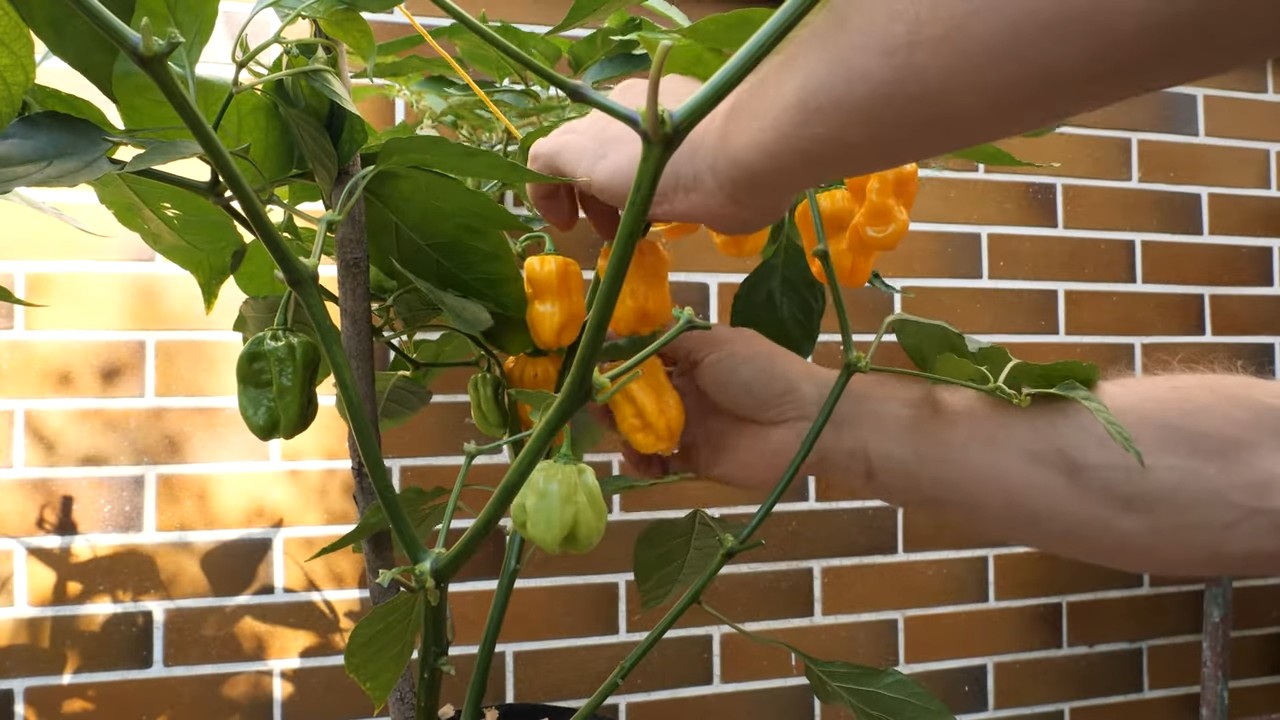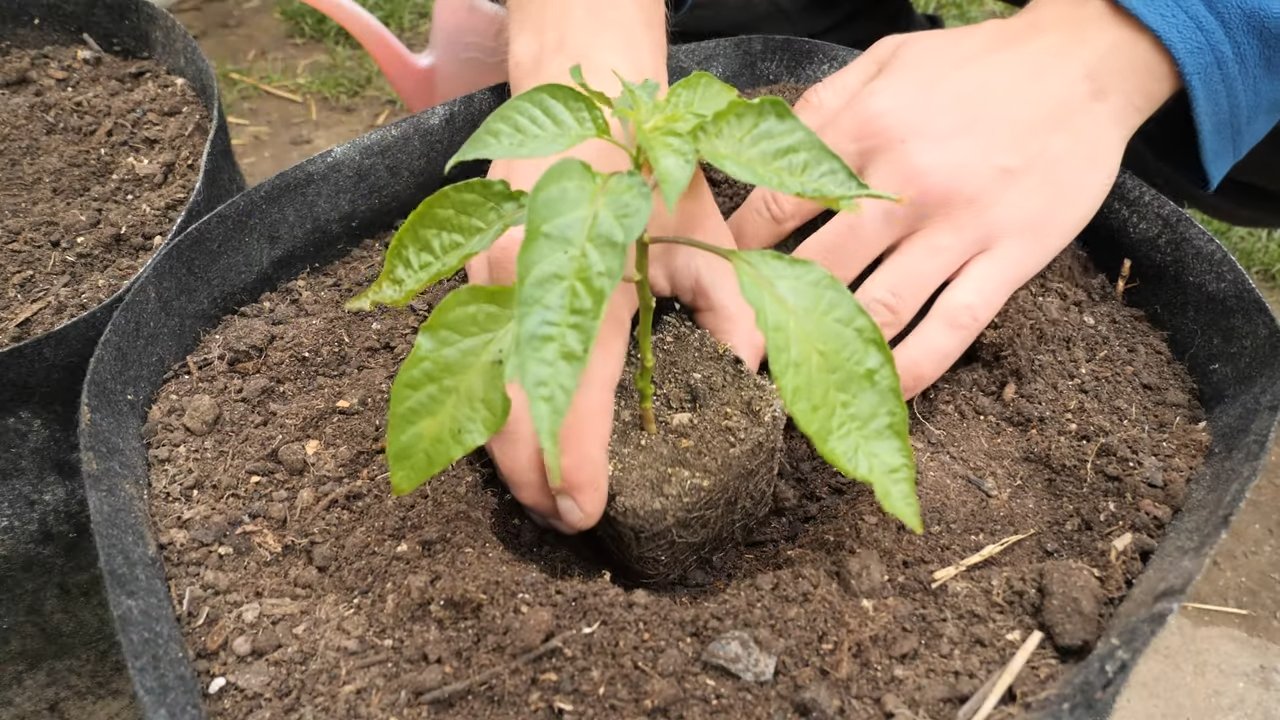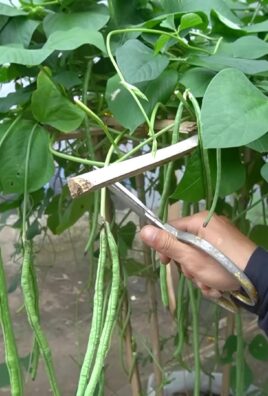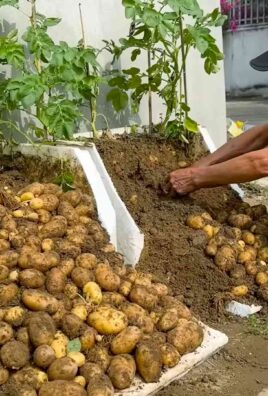Grow Habaneros at Home and ignite your culinary adventures! Imagine plucking fiery, sun-kissed habaneros straight from your own backyard, ready to add a thrilling kick to your favorite dishes. Forget bland store-bought peppers – with a few simple tricks, you can cultivate these flavor bombs yourself, even if you don’t have a sprawling garden.
The habanero, with its vibrant color and intense heat, boasts a rich history. Originating in the Amazon basin, it spread throughout the Americas, becoming a staple in cuisines from Mexico to the Caribbean. For centuries, it’s been more than just a spice; it’s a symbol of passion, flavor, and culinary artistry.
Why should you embark on this DIY journey? Because growing your own habaneros is incredibly rewarding! Not only will you have a constant supply of fresh, potent peppers, but you’ll also gain a deeper connection to your food. Plus, it’s a fantastic way to save money and reduce your reliance on grocery stores. I’m going to show you some easy-to-follow hacks that will help you grow habaneros at home successfully, regardless of your gardening experience. Get ready to turn up the heat!

Growing Habaneros at Home: From Seed to Spicy Harvest!
Okay, spice lovers, listen up! I’m going to walk you through everything you need to know to grow your own fiery habaneros right at home. Trust me, there’s nothing quite like the satisfaction of harvesting peppers you’ve nurtured from tiny seeds. It’s easier than you might think, and the flavor is incredible!
Getting Started: Seeds, Soil, and Supplies
Before we dive into the nitty-gritty, let’s gather our supplies. Here’s what you’ll need:
* Habanero Seeds: Obviously! Make sure you get them from a reputable source to ensure good germination rates.
* Seed Starting Trays or Small Pots: These will be your nurseries for the baby pepper plants.
* Seed Starting Mix: This is a light, sterile soil mix specifically designed for seedlings. Regular potting soil can be too heavy.
* Potting Soil: Once your seedlings are bigger, you’ll need potting soil for transplanting.
* Grow Lights (Optional but Recommended): Especially if you’re starting seeds indoors during the winter months.
* Heat Mat (Optional but Recommended): Habaneros love warmth, and a heat mat will speed up germination.
* Watering Can or Spray Bottle: For gentle watering.
* Fertilizer: A balanced fertilizer for the seedling stage and a fertilizer higher in phosphorus and potassium for fruiting.
* Gardening Gloves: To protect your hands.
* Plant Labels and a Permanent Marker: To keep track of your different pepper varieties (if you’re growing more than one!).
* Pots or a Garden Bed: For transplanting your mature plants. Choose a size appropriate for habaneros (at least 5 gallons).
Phase 1: Starting Your Habanero Seeds Indoors
Habaneros have a long growing season, so starting them indoors early is crucial, especially if you live in a cooler climate. I usually start mine about 8-10 weeks before the last expected frost.
1. Prepare Your Seed Starting Trays: Fill your seed starting trays or small pots with seed starting mix. Gently tap the trays to settle the soil.
2. Sow the Seeds: Make a small indentation (about 1/4 inch deep) in the soil of each cell or pot. Place 2-3 habanero seeds in each indentation. This increases your chances of at least one seed germinating.
3. Cover the Seeds: Gently cover the seeds with a thin layer of seed starting mix.
4. Water Gently: Use a spray bottle or watering can with a gentle nozzle to moisten the soil. You want the soil to be damp, but not soggy.
5. Provide Warmth: Place your seed starting trays on a heat mat. Habaneros germinate best at temperatures between 80-90°F (27-32°C).
6. Provide Light: If you’re using grow lights, position them a few inches above the seed starting trays. If you’re relying on natural light, place the trays in a sunny window.
7. Maintain Moisture: Keep the soil consistently moist, but not waterlogged. Check the soil daily and water as needed.
8. Be Patient: Habanero seeds can take anywhere from 7 to 21 days to germinate, so don’t get discouraged if you don’t see sprouts right away.
9. Thin the Seedlings: Once the seedlings have emerged and have their first set of true leaves (the leaves that look like miniature pepper leaves, not the initial seed leaves), thin them out by snipping off the weaker seedlings at the soil line with scissors. Leave only the strongest seedling in each cell or pot.
Phase 2: Caring for Your Habanero Seedlings
Once your seedlings have sprouted, it’s time to give them some extra TLC.
1. Adjust the Grow Lights: As your seedlings grow, adjust the height of your grow lights to keep them a few inches above the plants.
2. Water Regularly: Continue to water the seedlings regularly, allowing the top inch of soil to dry out between waterings.
3. Fertilize: Once the seedlings have their second set of true leaves, start fertilizing them with a balanced liquid fertilizer diluted to half strength. Fertilize every 1-2 weeks.
4. Harden Off the Seedlings: About a week or two before you plan to transplant your seedlings outdoors, you’ll need to “harden them off.” This process gradually acclimates the seedlings to outdoor conditions, preventing transplant shock. Start by placing the seedlings outdoors in a sheltered location for an hour or two each day, gradually increasing the amount of time they spend outdoors each day. Also, gradually expose them to more sunlight.
5. Transplant to Larger Pots (If Necessary): If your seedlings outgrow their seed starting trays or small pots before it’s time to transplant them outdoors, transplant them to larger pots (about 4-inch pots) filled with potting soil.
Phase 3: Transplanting Your Habaneros Outdoors
The big day! Transplanting your habaneros outdoors is a crucial step.
1. Choose the Right Location: Habaneros need at least 6-8 hours of sunlight per day. Choose a location in your garden or on your patio that receives plenty of sunlight.
2. Prepare the Soil: Habaneros prefer well-drained soil that is rich in organic matter. Amend your soil with compost or other organic matter before transplanting.
3. Dig the Holes: Dig holes that are slightly larger than the root balls of your seedlings. Space the holes about 18-24 inches apart.
4. Transplant the Seedlings: Gently remove the seedlings from their pots, being careful not to damage the roots. Place the seedlings in the holes and backfill with soil.
5. Water Thoroughly: Water the seedlings thoroughly after transplanting.
6. Mulch: Apply a layer of mulch around the base of the plants to help retain moisture and suppress weeds.
Phase 4: Caring for Your Habanero Plants Outdoors
Now that your habaneros are in their permanent homes, it’s time to provide them with the care they need to thrive.
1. Water Regularly: Water your habanero plants regularly, especially during hot, dry weather. Allow the top inch of soil to dry out between waterings.
2. Fertilize: Once the plants start to flower, switch to a fertilizer that is higher in phosphorus and potassium. These nutrients promote flowering and fruiting. Fertilize every 2-3 weeks.
3. Provide Support: Habanero plants can get quite tall and bushy, so they may need support to prevent them from falling over. Use stakes or cages to support the plants.
4. Pest Control: Keep an eye out for pests such as aphids, whiteflies, and spider mites. If you find any pests, treat them with an appropriate insecticide or insecticidal soap. I prefer using neem oil as a natural solution.
5. Pruning (Optional): Pruning your habanero plants can help to improve air circulation and encourage bushier growth. Remove any dead or yellowing leaves. You can also pinch off the tips of the branches to encourage more branching.
Phase 5: Harvesting Your Habaneros
The moment we’ve all been waiting for!
1. When to Harvest: Habaneros are typically ready to harvest about 80-100 days after transplanting. The peppers will turn from green to orange or red when they are ripe.
2. How to Harvest: Use scissors or pruning shears to cut the peppers from the plant. Be careful not to damage the plant.
3. Handle with Care: Habaneros are very hot, so wear gloves when handling them. Avoid touching your eyes or face after handling habaneros.
4. Enjoy Your Harvest: Use your habaneros to make hot sauce, salsa, or other spicy dishes. You can also dry them for later use.
Tips and Tricks for Growing the Best Habaneros
Here are a few extra tips to help you grow the best habaneros possible:
* Consistent Watering is Key: Inconsistent watering can lead to blossom end rot, a common problem in peppers.
* Don’t Over-Fertilize: Too much nitrogen can lead to lush foliage but fewer peppers.
* Protect from Frost: Habaneros are very sensitive to frost. If frost is predicted, cover your plants with blankets or move them indoors.
* Pollination: While habaneros are self-pollinating, you can improve fruit set by gently shaking the plants or using a small paintbrush to transfer pollen from one flower to another.
* Save Seeds: If you want to grow habaneros again next year, you can save the seeds from your

Conclusion
So, there you have it! Growing habaneros at home isn’t just a gardening project; it’s an adventure in flavor, a testament to your green thumb, and a guaranteed way to spice up your culinary creations. We’ve walked you through the process, from selecting the perfect seeds to nurturing your plants to a bountiful harvest. But why is this DIY trick a must-try?
Firstly, the flavor. Store-bought habaneros, while readily available, often lack the vibrant, nuanced heat and fruity undertones of homegrown peppers. When you grow your own, you control the environment, the nutrients, and ultimately, the taste. You’ll be rewarded with peppers that pack a punch and deliver a complex flavor profile that will elevate your dishes to a whole new level.
Secondly, the satisfaction. There’s an undeniable sense of accomplishment that comes with nurturing a plant from seed to fruit. Watching your habanero plants thrive, knowing that you’re responsible for their growth, is incredibly rewarding. It’s a tangible connection to nature and a reminder of the power of patience and care.
Thirdly, the cost savings. While there’s an initial investment in seeds, soil, and perhaps a few supplies, growing your own habaneros can save you money in the long run. Habaneros can be quite expensive to purchase, especially if you use them frequently. With a successful harvest, you’ll have a steady supply of these fiery peppers at your fingertips, without breaking the bank.
But the benefits don’t stop there. Growing habaneros at home is also a sustainable choice. You’re reducing your reliance on commercially grown peppers, which often involve pesticides and long-distance transportation. By growing your own, you’re contributing to a more environmentally friendly food system.
Now, let’s talk about variations. Feel free to experiment with different growing methods. Try hydroponics for a faster, more efficient harvest. Or, if you’re short on space, consider growing your habaneros in containers on your balcony or patio. You can also explore different varieties of habaneros, from the classic orange to the chocolate or red varieties, each with its unique flavor and heat level.
Don’t be afraid to get creative with your habaneros. Use them to make your own hot sauce, salsa, or chili oil. Add them to your favorite stews, curries, or stir-fries. Or, if you’re feeling adventurous, try pickling them for a spicy snack. The possibilities are endless!
We understand that growing habaneros can seem daunting, especially if you’re a beginner gardener. But with a little patience, attention, and the right information, you can successfully grow these fiery peppers at home. We’ve provided you with the knowledge and tools you need to get started. Now, it’s up to you to take the plunge.
So, what are you waiting for? Grab some seeds, prepare your soil, and get ready to embark on a spicy adventure. We encourage you to try this DIY trick and experience the joy of growing your own habaneros. And don’t forget to share your experience with us! We’d love to hear about your successes, your challenges, and your favorite ways to use your homegrown habaneros. Share your photos, recipes, and tips in the comments below. Let’s create a community of habanero enthusiasts and inspire others to grow their own! Remember, the key to success is to start small, be patient, and don’t be afraid to experiment. Happy growing!
Frequently Asked Questions (FAQ)
What is the best time of year to start growing habaneros?
The best time to start growing habaneros depends on your climate. In general, you should start your seeds indoors 6-8 weeks before the last expected frost. This will give your seedlings a head start and allow them to mature before being transplanted outdoors. If you live in a warmer climate with a longer growing season, you can start your seeds directly outdoors after the last frost. However, starting indoors is generally recommended for better control over the growing environment.
How much sunlight do habanero plants need?
Habanero plants need at least 6-8 hours of direct sunlight per day to thrive. Choose a location in your garden that receives plenty of sunlight throughout the day. If you’re growing your habaneros in containers, make sure to place them in a sunny spot on your balcony or patio. If you don’t have enough natural sunlight, you can supplement with grow lights.
What kind of soil is best for growing habaneros?
Habaneros prefer well-draining soil that is rich in organic matter. A good potting mix for habaneros should contain a blend of peat moss, perlite, and vermiculite. You can also amend your garden soil with compost or aged manure to improve its fertility and drainage. Avoid using heavy clay soil, as it can retain too much moisture and lead to root rot.
How often should I water my habanero plants?
Water your habanero plants regularly, especially during hot, dry weather. The soil should be kept consistently moist, but not waterlogged. Water deeply whenever the top inch of soil feels dry to the touch. Avoid overwatering, as this can lead to root rot. During cooler weather, you may need to water less frequently.
What kind of fertilizer should I use for habanero plants?
Habanero plants benefit from regular fertilization. Use a balanced fertilizer with equal amounts of nitrogen, phosphorus, and potassium (e.g., 10-10-10) during the early stages of growth. Once your plants start to flower and produce fruit, switch to a fertilizer that is higher in phosphorus and potassium (e.g., 5-10-10) to promote fruit development. Follow the instructions on the fertilizer package for application rates.
How do I protect my habanero plants from pests and diseases?
Habanero plants can be susceptible to various pests and diseases, such as aphids, spider mites, and fungal infections. To prevent these problems, inspect your plants regularly for signs of infestation or disease. If you spot any pests, you can try spraying them with insecticidal soap or neem oil. To prevent fungal diseases, make sure to provide good air circulation around your plants and avoid overwatering. You can also use a fungicide if necessary.
When are habaneros ready to harvest?
Habaneros are typically ready to harvest about 90-100 days after transplanting. The peppers will turn from green to orange, red, or chocolate, depending on the variety. The color change indicates that the peppers are ripe and ready to be picked. Use gloves when harvesting habaneros, as the capsaicin oil can irritate your skin.
How do I store habaneros?
Habaneros can be stored in several ways. You can refrigerate them for up to a week, or you can freeze them for longer storage. To freeze habaneros, wash and dry them thoroughly, then place them in a freezer bag or container. You can also dry habaneros by stringing them together and hanging them in a well-ventilated area. Dried habaneros can be stored in an airtight container for several months. Another option is to pickle habaneros in vinegar or brine.
Can I grow habaneros indoors?
Yes, you can grow habaneros indoors, but you’ll need to provide them with adequate light and warmth. Place your plants near a sunny window or use grow lights to supplement the natural light. Keep the temperature consistent and avoid drafts. Make sure to water your plants regularly and fertilize them as needed.
My habanero plant is flowering, but not producing fruit. What could be the problem?
There are several reasons why your habanero plant might be flowering but not producing fruit. One possibility is that the flowers are not being pollinated. You can try hand-pollinating the flowers by using a small brush to transfer pollen from one flower to another. Another possibility is that the plant is not getting enough nutrients. Make sure to fertilize your plant regularly with a fertilizer that is high in phosphorus and potassium. Stress from temperature fluctuations or inconsistent watering can also cause flower drop. Ensure consistent watering and try to maintain a stable temperature.




Leave a Comment